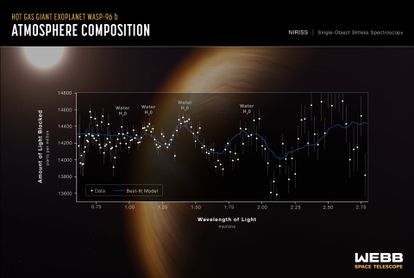Those responsible for the James Webb
Space Telescope
today published all the first images taken by this astronomical observatory, the largest ever launched into space.
New snapshots and scientific data portray giant exoplanets, compact groups of galaxies, and the brightest known nebula.
These images follow the announcement made yesterday by US President Joe Biden, with the first full color snapshot taken by this instrument.
More information
The telescope that observes how light was born in the universe
The images mark the beginning of the scientific operations of this observatory, developed by the US in collaboration with Europe and Canada.
In this first batch of images the
Webb
has portrayed these four objects:
Southern Ring Nebula.
This huge expanding cloud of gas surrounds a dying star 2,000 light-years from Earth.
It is only visible from the southern hemisphere.
The Webb has portrayed the bag of gas and dust produced by the dying star and also shows the other star present in this object.
The points of light surrounding the nebula are not stars, but galaxies.
These types of observations will help to better understand the evolution of stars.
It is the top image of this news.
WASP-96b.
A giant planet somewhat larger than Jupiter that is 1,150 light years away.
If on Earth a year lasts 365 days, the time it takes for our planet to complete an orbit around the Sun, this world is so close to its star that each year lasts just three and a half days.
The main characteristic of this huge gaseous world is that, unlike Jupiter or Saturn, it does not appear to have clouds.
The
Webb
has revealed that in the atmosphere of this hot gaseous planet there is water and clouds, contrary to what was thought.
This new ability to detect essential molecules for life on very distant planets will be key in the search for organic traces on dozens of exoplanets.
This is the atmosphere of WASP-96b, a giant planet slightly larger than Jupiter that is 1,150 light-years away.NASA and ESA
Stephan's Quintet.
The first compact group of galaxies, discovered in 1877 by the French astronomer Édouard Jean-Marie Stephan.
It is about 300 million light years away.
Four of its galaxies are united by their forces of gravity in a violent choreography that sometimes makes them collide at millions of kilometers per hour, which revives the birth of new stars.
Webb has captured the quintet in an image that stitches together data from the mid- and near-infrared detectors.
The snapshot of these five bodies and the rest that are distributed around them is a compendium of the different stages of the evolution of galaxies.
The 'Webb' offers a view of the thick dust of Stephan's Quintet, a cluster of galaxies about 300 million light-years away.NASA, ESA, CSA, STScI
The Carina Nebula
.
Located 7,600 light-years from Earth, it is the brightest known nebula and stars are being born and dying inside it.
The image announced yesterday by Biden is the most distant and precise that has been obtained from the deep universe in the infrared spectrum, according to NASA.
It shows SMACS 0723, a region of the sky visible from the southern hemisphere where a large cluster of galaxies stands out 4.6 billion light years from Earth.
The gravitational pull of this cluster warps space and time and works like a lens that magnifies the light from much more distant and dim galaxies behind it.
The
Webb
image shows that the instrument can capture this phenomenon and pursue one of its main goals: to see further into the universe than any other telescope, to capture the light of the first stars born after the Big Bang, the explosion with which The universe was born 13.7 billion years ago.
SMACS 0723, a region of the sky visible from the southern hemisphere.NASA
The selection of these first five objectives has taken more than five years of study between the three space agencies responsible for the project.
This set of images "is intended to highlight the enormous capabilities of
Webb
's instruments and give an idea of what is to come," said Klaus Pontoppidan, one of the mission's scientific leaders.
“Surely these images start a wow!, to astronomers and the general public”, he added in a press release.
The James Webb
Telescope
launched last December and arrived at its destination in February.
The process of deploying its mirror and its huge sunshield is the most complex ever carried out by NASA and its European and Canadian partners, who have participated in the development of several of the observatory's four instruments.
The Spanish participation in this mammoth experiment is coordinated by Santiago Arribas and Luis Colina, from the Astrobiology Center in Madrid.
"These first images are not going to disappoint anyone and from a scientific point of view they are going to demonstrate the potential that James Webb has in the different fields of astrophysics for which it has been designed," says Arribas.
The observatory is orbiting the Sun at the second Lagrange point, 1.5 million kilometers from our planet.
Its six and a half meter diameter gold-plated mirror is the largest ever deployed in space and will be able to observe the most distant and oldest objects in the universe, including the first galaxies and the first stars born just 100 million years ago. years after the Big Bang.
The observatory is specialized in capturing infrared light —invisible to human eyes— emitted by this type of object.
In addition, it is the first to be able to see through dust clouds and reveal the appearance of the stars behind them.
Thanks to the
Webb
and other existing telescopes, such as
Hubble
and
Chandra
, humanity will be able to observe the cosmos in a light range and with an unprecedented level of detail.
You can follow
MATERIA
on
,
and
, or sign up here to receive
our weekly newsletter
.

